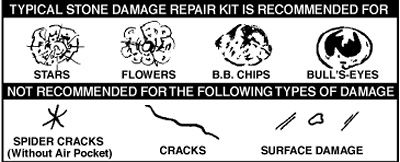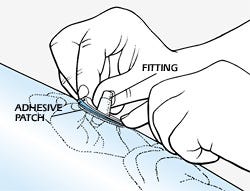how to fix crack in windshield
It's a gorgeous day. The sun is shining, traffic is moving along smartly. But suddenly—whack! There's a rosebud the size of a quarter smack in the windshield, directly in your line of sight.
You didn't see whatever projectile caused this thing either coming or going, but as your heartbeat returns to normal, the awful truth sinks in: You're going to have to have the windshield replaced. This means dealing with the glass shop, being without your car for a day or two, having a potentially leaky windshield and, worst of all, risking higher insurance premiums.
It doesn't actually have to be this way, though. A cracked windshield can happen at any time, but repairing the damage yourself is easier than you think, thanks to some smart products you can get usually for less than $10. The only additional investment you have to make: A little time and patience.

It's well worth considering, as some insurance policies won't even cover chipped glass. On average, windshield repairs cost about $250, but fixes for premium or luxury cars can be far more expensive, potentially topping $1,000. Sure, you might be able to just raise or lower your seat an inch so you didn't have to look right through the chip, but it's not a great strategy—small cracks can propagate into larger ones in an instant, and damaged glass can become a safety issue, as it weakens its resistance to future projectiles.
Left alone, water will find its way into the chip, pulled in by surface tension. If the chip goes all the way through the top lamination, any moisture that gets that deep can delaminate the glass from the center membrane. Eventually, the membrane will fog, causing a larger blemish. Water also can freeze in the chip, causing a larger flaw or even a crack. Finally, water can carry dirt into the crack—and there's no way to flush it out. None of these are attractive propositions.
But before you panic, drive home and get out your magnifying glass. Take a close look at your new chip. It just might be possible to repair it instead of replacing the entire windshield, simply by injecting an epoxy or acrylic compound into the chip to act as an adhesive or filler. Do this as soon as possible, and you'll save yourself the headache of a full replacement, and also become the savvy car-repair genius you always thought you were.
Of course, not all chips can be fixed, nor all blemishes erased entirely. The best you can hope for is to fill most of the chip, and live with a visible flaw in your otherwise crystal-clear glass. But the improvement on most chips will be dramatic, and at least you've sealed the chip from the atmosphere and probably eliminated the possibility of it growing larger or discoloring in the future.
By the way: You can't fix long cracks. If that's what you've got, bite the bullet and get over to the repair shop. But pretty much any chip that goes into the glass perpendicular to the surface or at a shallow angle can be repaired. That includes cone-shaped chips, leaf-shaped chips or almost any chip that hasn't flaked a big piece of glass off onto the road.

Windshield Repair Kits
Windshield crack repair kits can be found in the auto parts department of many retailers like Walmart and Target, as well as more traditional auto parts stores like Pep Boys and AutoZone. Failing that, the warehouse-distributor auto parts stores that cater to professional mechanics can supply you. Of course, there's also Amazon, which can sling a repair kit to your door usually overnight. A good gauge there is the customer reviews, and our survey found multiple options from Permatex, RainX, ARISD, Loctite, and Gliston.
Procedures differ marginally, but the principle is the same. We fixed a couple of windshields to test some of these products, and the results were excellent. Read our report below—but regardless of which kit you use, remember to start with an absolutely dry windshield that's somewhere near room temperature. You don't want to trap any water in the repair, so use a hair dryer if the window is wet.
If the surface is dirty, don't use any detergents or window cleaner. Lighter fluid or acetone can help dry and clean the surface, but don't use so much that it dribbles down the glass and peels the paint, or worse.
Test #1: Pre-Mixed Adhesive
We first used a simple kit from Loctite with a one-part adhesive and an uncomplicated syringe to apply it. Start by peeling off the backing film on one side of the precut adhesive strip and applying it to the pre-cleaned glass, centered over the chip. Burnish with the back of your thumbnail or a blunt object. Now peel the remaining film.
Orient the plastic adapter so that the fitting is as close to vertical as possible and stick it to the film. Burnish again. Pull the cap off the syringe, keeping it pointy-end-up so the adhesive doesn't wind up on the fender. Attach the syringe to the adapter.
Now here's the tricky part: Lay your watch down somewhere so you can see the second hand, or set up your smartphone in stopwatch mode. Grasp the syringe body with one hand to stabilize it, and pull the handle of the syringe out as far as it will go. Hold the handle in this position for a full minute. This pulls a partial vacuum in the syringe—and in the crack.
While you're holding this vacuum, the air in the crack bubbles up through the adhesive in the syringe, while adhesive creeps down toward the glass and chip. Now let go of the handle. Don't follow the handle, but let it go abruptly. The pressure wave from the handle slamming down will force adhesive into the crack.
Repeat this suck-and-slam operation a half-dozen times or so, forcing the crack virtually full of adhesive. Now remove the syringe, adapter, and adhesive sheet. There will be a film of adhesive on the surface of the glass. You can chase that back with an alcohol-dampened paper towel, but leave the pimple of adhesive right above the crack undisturbed until it cures for a few hours.
With the pimple hardened, simply take a single-edge razor blade and shave the protruding adhesive off. Use a sharp blade, and you'll be able to do this in a single pass.

Test #2: Two-Part Adhesive
We also tried a repair kit that used a two-part adhesive. These are far less common—though you might find them in your search and be forced to use one in a pinch—and they require users to mix two small vials of adhesive and hardener in the syringe before starting, which was simple.
The adhesive disc and syringe adapter are similar, if not identical, to the simpler kit's, and are applied in an identical fashion. The syringe, however, is more complex. It uses a wire latch arrangement on the body that drops into two notches on the handle when necessary.
A simple pushpin stuck into the body serves as a very crude valve to let air in and out of the body. Once the syringe is attached to the adapter (the adapter already being stuck airtight to the glass), you remove the pushpin. Then you bottom the syringe plunger, pushing the air out, insert the pin, and pull the handle out until the clip clicks into the slot. This will hold the plunger out, and the partial vacuum under it for the designated time.
Rather than rapidly releasing the pressure like you do with the Loctite kit, in this case you remove the pin, admitting air into the syringe barrel. Then you replace the pin, sealing the hole, followed by releasing the clip, pushing the handle in to lightly pressurize the barrel and force adhesive into the chip for a minute or so. The second slot will trap the clip as soon as you've pushed in far enough. Repeat this "vent, suck, vent, squeeze" operation several times to force adhesive into the crack.
While the clip-and-slot and vent system relieves you of the necessity of constantly grasping the syringe barrel like it's the last beer at the picnic, there are caveats. The vacuum pulled isn't as good, purging less air on every iteration. And the simpler Loctite kit seemed to force the adhesive deeper into the crack faster by using the plunger as a piston to rapidly pressurize the system.
Having said that, both kits did a great job. After shaving the excess adhesive off, both cracks were barely visible. The adhesive remained clear, and has the same refractive index as the glass so that it renders the crack invisible from almost any angle.
One final warning: Don't try to depress the plunger by hand and squeeze the adhesive deeper into the glass with either kit. The adhesive patch might become unglued and squirt adhesive all over your windshield and fender and shirt. Don't ask how we know this.
How It Works: Laminated Safety Glass
Ordinary window glass, like you have around the house, is pretty amazing stuff. It's clear, strong and cheap. But it's also brittle, shattering into long, dangerous, wickedly sharp shards when overstressed. Plastics would be as strong, but not nearly hard enough to resist scratching and remain clear enough for a car window—just look at any plastic-glazed outdoor bus stop or phone booth, with its patina of fine scratches.
For the side windows of cars, automakers have come up with a good compromise: tempered glass. It's stronger than standard, but more importantly, when it does shatter it breaks up into small granules. These granules are still sharp, but should do less damage than the long shards of untempered glass. However, for a windshield, constantly bombarded by pebbles, tempered glass would have a short life span.
So, many years back, the car manufacturers switched to a laminated glass sandwich for the windshield. It's a simple process. Two thinner sheets of glass are fused to a rubber inner layer. The tempered-glass outer layers are then independent of each other. The rubbery center sheet provides damping to any shock waves from errant stones, reducing the probability of breakage.
And if the glass is hit by an object hard enough, odds are that only the outer sheet will break, as is the case with most stone chips. If a really big piece of debris hits the glass hard enough to break both inner and outer layers, the tough membrane prevents it from winding up in your lap.
Even better, the shards of glass from the inner lamination wind up stuck to the membrane, keeping them from spalling away from the windshield at a high velocity, causing great havoc.
Eric Adams Eric Adams is a writer and photographer who focuses on technology, transportation, science, travel, and other subjects for a wide range of outlets, including Wired, The Drive, Gear Patrol, Men's Health, Popular Science, Forbes, and others.
This content is created and maintained by a third party, and imported onto this page to help users provide their email addresses. You may be able to find more information about this and similar content at piano.io
how to fix crack in windshield
Source: https://www.popularmechanics.com/cars/how-to/a77/easy-windshield-repair/
Posted by: johnsonwousidersing.blogspot.com

0 Response to "how to fix crack in windshield"
Post a Comment